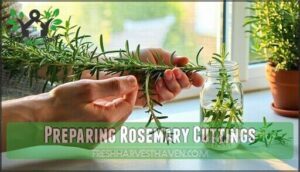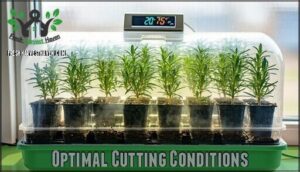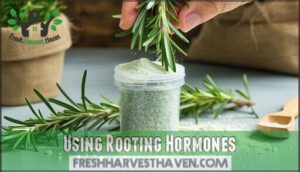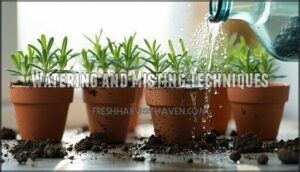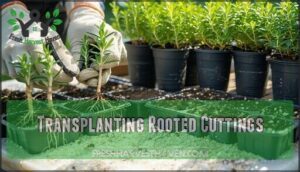This site is supported by our readers. We may earn a commission, at no cost to you, if you purchase through links.
 You can propagate rosemary from cuttings easily using two proven methods.
You can propagate rosemary from cuttings easily using two proven methods.
Take 4-6 inch cuttings from healthy, non-flowering stems in spring or early summer. Strip the lower leaves and either place cuttings in fresh water or plant directly in moist sand.
Water propagation shows roots faster—usually within 2-3 weeks—while sand-rooted cuttings develop stronger root systems.
Keep your setup in bright, indirect light at 65-75°F with consistent moisture. Success rates jump dramatically when you understand the subtle differences between timing, cutting selection, and environmental conditions that separate thriving plants from disappointing failures, which can be influenced by consistent moisture and the right environmental conditions.
Table Of Contents
- Key Takeaways
- Preparing Rosemary Cuttings
- Optimal Cutting Conditions
- Rooting Rosemary Cuttings
- Promoting Cutting Survival
- Transplanting Rooted Cuttings
- Frequently Asked Questions (FAQs)
- What is the quickest way to propagate rosemary?
- Can you grow rosemary from store-bought cuttings?
- How long does rosemary cutting propagation take?
- Can you propagate rosemary in water instead?
- What common mistakes kill rosemary cuttings quickly?
- How many cuttings should I take simultaneously?
- When will propagated rosemary be ready for harvest?
- Can I propagate rosemary in water instead?
- What are common signs of cutting failure?
- Should I fertilize newly rooted rosemary cuttings?
- Conclusion
Key Takeaways
- Choose semi-hardwood stems from healthy plants – You’ll get 90% success rates by selecting 4-6 inch cuttings from non-flowering stems during late spring to early summer, when plants are actively growing.
- Create optimal rooting conditions – Keep your cuttings at 70-77°F with 70-80% humidity and bright indirect light, using rooting hormone to boost success rates from 40% to 92%.
- Use proper substrate and watering techniques – Plant in a sterile, well-draining medium like perlite or sand, and mist daily to maintain moisture without waterlogging, which kills more cuttings than drought.
- Wait for strong root development before transplanting – You’ll see roots in 2-4 weeks, but wait for 2cm of visible growth and gradually harden off plants over 7 days to prevent transplant shock.
Preparing Rosemary Cuttings
Success in rosemary propagation starts with selecting the right material from healthy plants.
You’ll want to choose non-flowering stems from disease-free parent plants during late spring to early summer when success rates peak at 90%.
Prime time is late spring to early summer—that’s when your rosemary cutting success peaks at 90%.
Choosing Healthy Parent Plants
For successful rosemary cutting propagation, you’ll want to start with a champion parent plant that screams health and vitality. Disease resistance and strong genetic traits transfer directly to your new plants, making parent selection essential.
Look for rosemary plants displaying these winning characteristics:
- Plant vigor – actively growing with strong branching
- Foliage health – vibrant green leaves without yellowing
- Stem quality – firm, disease-free branches
- Mature establishment (at least one growing season)
- Zero signs of pests or fungal issues
Healthy parents produce resilient rosemary cuttings with superior rooting potential.
Selecting Right Stem Cuttings
Semi-hardwood stems aged 6-12 months give you the best rosemary propagation success.
Choose mature stems over tender shoots for double the rooting power.
Look for 7-12 cm cuttings with smooth, green bark condition and 3-4 node placement points.
Choose medium-thickness stems (3-5mm) from healthy upper sections.
Strip lower leaves but keep 2-3 top leaves for photosynthesis.
Avoid flowering shoots—they resist rooting by 40%.
Timing for Cutting Collection
Timing your seasonal cuttings right makes all the difference in rosemary propagation. Late spring to early summer delivers maximum stem maturity when shoots reach semi-hardwood stage before bloom stage begins.
Time of day matters too—collect cuttings during morning hours after dew evaporates but before afternoon heat stresses plants. This timing guarantees your cuttings maintain maximum moisture for successful rooting rosemary.
- Avoid rainy periods that increase fungal risks during plant propagation
- Choose non-flowering stems for better energy focus on root development
- Select days with mild weather impact to minimize cutting stress
Optimal Cutting Conditions
Once you’ve prepared your rosemary cuttings, creating the right environment becomes essential for successful rooting.
The key lies in balancing three critical factors: maintaining temperatures between 68-77°F, keeping humidity at 70-80%, and providing bright indirect light for 12-14 hours daily.
Temperature Requirements
Ideal temperatures release your rosemary’s rooting speed potential.
Maintain 70-77°F (21-25°C) for best results—this range boosts success rates by 30%.
Temperature control matters more than you’d think; consistent warmth beats wild swings every time.
Heating methods like seedling mats work wonders during seasonal variance, especially when Mother Nature throws curveballs.
Your propagate rosemary success depends on this foundation.
Humidity Control Methods
Proper humidity control transforms struggling rosemary cuttings into thriving plants.
You’ll want humidity domes or clear plastic covers to maintain 70-80% relative humidity around your cuttings.
Humidity sensors help you monitor levels precisely, while adjusting misting frequency keeps moisture consistent.
Don’t forget ventilation needs – briefly open covers daily to prevent fungal issues.
This balance between moisture retention and air circulation gives your rosemary cuttings the best chance to propagate rosemary successfully using proven plant propagation tips.
Light Exposure Needs
While humidity keeps your cuttings comfortable, light exposure determines whether they’ll thrive or struggle. You’ll want bright, indirect light that mimics a cloudy spring day.
Direct sunlight acts like a magnifying glass, scorching delicate leaves before roots can establish. Position your rosemary cuttings 3-4 feet from south-facing windows or use sheer curtains to filter harsh rays.
Light intensity should feel gentle on your hand when placed near the cutting. Photoperiod effects show that 12-14 hours of consistent daily light promotes maximum root development. For best results, verify your cuttings receive the minimum direct sunlight they need.
- Spectral quality: LED or fluorescent grow lights provide ideal blue spectrum wavelengths
- Etiolation risk: Watch for pale, stretched stems indicating insufficient light
- Shading duration: Gradually reduce shade as roots develop over 2-3 weeks
- Rosemary care: Monitor leaf color changes as your first indicator of lighting success
Proper lighting transforms weak, spindly growth into robust propagating herbs ready for transplanting.
Rooting Rosemary Cuttings
Once you’ve prepared your cuttings, it’s time to get them rooted and growing strong.
You’ll need the right hormone treatment, growing medium, and watering schedule to turn those stems into thriving new plants.
Using Rooting Hormones
Rooting hormones act like growth catalysts for your rosemary cuttings. Hormone types like IBA (indole-3-butyric acid) at 750ppm deliver 92% rooting success compared to 40-60% without treatment.
Application methods matter—use quick-dip techniques on dry stems, tapping off excess powder to prevent clumping. Concentration levels are vital since overtreatment causes leaf twisting and reduced stimulation.
Commercial powders like Hormex offer reliable results for propagating herbs. You can purchase IBA rooting hormone online for convenience.
This dramatic improvement in rooting success makes the small investment worthwhile when you’re serious about rosemary propagation.
Sterile Substrate Options
After applying rooting hormone, your substrate choice determines whether your rosemary cuttings thrive or fail. Perlite vs Vermiculite presents a key decision—perlite drains quickly while vermiculite holds moisture longer.
Coco Coir offers excellent drainage with natural antifungal properties, and Rockwool Cubes provide consistent moisture distribution. Considering water retention differences is essential for successful rooting.
Substrate Sterilization eliminates pathogens that doom herb propagation. Steam-treat your medium at 180°F for thirty minutes, or microwave small batches for ten minutes.
Here are five game-changing substrate options for how to propagate rosemary:
- Sterile perlite – Creates perfect air pockets for root development
- Heat-treated vermiculite – Retains just enough moisture without drowning roots
- Sterilized sand alternatives – Prevents waterlogging that kills cuttings
- Pre-packaged seed mixes – Already sterile and pH-balanced
- Coconut coir blends – Natural antifungal protection for your plant propagation methods
Watering and Misting Techniques
With your rosemary cuttings nestled in substrate, mastering watering and misting techniques determines success or failure.
Daily misting maintains ideal humidity levels between 70-80% without creating waterlogged conditions that doom root health. Use distilled water to avoid mineral buildup, and mist gently like morning dew rather than drenching your precious cuttings.
Watch for overwatering signs including yellowing leaves or musty odors. Proper misting frequency supports how to propagate rosemary effectively, giving your herb propagation project the moisture balance it craves.
These plant propagation techniques guarantee your rosemary cuttings develop strong roots. To prevent this, consider adjusting watering frequency based on weather.
Promoting Cutting Survival
Once your rosemary cuttings develop roots, you’ll need to focus on three critical survival factors that can make or break your propagation success.
Managing water loss, preventing disease, and encouraging strong callus formation will determine whether your cuttings thrive or fail during this vulnerable stage.
Minimizing Water Loss
Your cuttings face a delicate balancing act between staying hydrated and avoiding rot. Water loss can quickly kill developing rosemary before roots establish properly. Think of your cuttings as marathon runners who need consistent hydration without drowning.
Master these four essential techniques for growing rosemary successfully:
- Cuticle Protection – Apply anti-transpirants to seal leaf surfaces and reduce moisture escape through stomata control
- Leaf Reduction – Trim leaves by half to decrease transpiration while maintaining photosynthesis for healthy plant care
- Humidity Domes – Create mini-greenhouses with clear plastic covers maintaining 70-80% humidity around cuttings
- Strategic Ventilation – Provide gentle airflow preventing stagnant conditions while preserving moisture levels
This rosemary guide emphasizes precision over guesswork. Your rosemary tips should focus on maintaining that sweet spot where cuttings stay moist but not waterlogged. Understanding the importance of wind protection methods can also help prevent moisture loss. Remember, patience pays off—rushed hydration often backfires.
Preventing Fungal Growth
While protecting your rosemary cuttings from water loss matters, fungal diseases pose an even greater threat to success.
Air Circulation prevents stagnant moisture that breeds problems, while Sterile Tools cleaned with alcohol stop pathogen spread. Choose disease-free Substrate Choice like sterile perlite, and apply Fungicide Use sparingly when needed.
For ideal defense, consider rosemary-specific solutions. Monitoring Humidity below 80% keeps your rosemary healthy—these rosemary tips prevent plant diseases from destroying your rosemary herbs propagation efforts.
| Prevention Method | Application | Success Rate |
|---|---|---|
| Sterile substrate | Use commercial mix | 95% cleaner |
| Air circulation | Small fan setup | 60% less rot |
| Tool sterilization | 70% alcohol wipe | 95% pathogen reduction |
Enhancing Callus Formation
Once you’ve tackled fungal concerns, callus formation becomes your next victory. This healing tissue kickstarts successful rooting through natural wound response mechanisms.
Here are five callus-boosting strategies:
- Select smooth-barked stems over woody ones for faster cell differentiation
- Maintain consistent moisture to support auxin transport pathways
- Keep temperatures steady at 68-77°F for ideal callus composition
- Choose non-flowering laterals since genetic factors favor active growth zones
- Remove lower leaves to expose nodes where callus develops best
Plant tissue culture principles show that proper plant propagation depends on this cellular bridge between cutting and roots.
Transplanting Rooted Cuttings
Your rooted cuttings are ready for transplant when they show about 2 cm of visible root growth, which typically happens after 2-4 weeks in the propagation medium.
The key to success lies in gradually hardening off your baby rosemary plants and choosing the right soil conditions to prevent transplant shock.
Hardening Off Process
Before moving your rooted rosemary cuttings outdoors permanently, they need gradual acclimation to survive environmental stressors.
Begin the outdoor relocation by exposing your rosemary clones to just two hours of sunlight exposure daily, then increase incrementally over seven days.
This plant propagation technique builds tolerance to wind and temperature changes.
Adjust your watering schedule accordingly, as outdoor conditions require more frequent monitoring than indoor environments.
Soil Selection and Preparation
Your hardened rosemary cuttings deserve proper soil preparation to thrive. Select well-draining sandy loam with soil pH between 6.0-7.0 for maximum nutrient content absorption.
Heavy clay soils slash success rates by 40%, so improve drainage needs by mixing in perlite or coarse sand. Use sterilization methods like pasteurization to create sterile growing medium—this prevents fungal diseases by 80%. Skip rich soil amendments that attract pathogens to vulnerable rosemary varieties.
- Sandy loam feels like freedom for cramped roots finally able to breathe
- Perfect pH releases nutrients your rosemary clones have been craving
- Sterile soil means safety from invisible enemies lurking in contaminated mix
- Good drainage prevents heartbreak of watching your plant propagation efforts rot away
- Clean preparation shows respect for the rosemary varieties you’ve worked to clone
Post-Transplant Care and Maintenance
Once your soil is ready, your newly transplanted rosemary needs attentive care to establish strong roots.
Water when the top inch feels dry—soggy soil kills more rosemary than drought does. Skip fertilizing for six weeks; young roots can’t handle nutrients yet. To promote healthy growth, consider proper herb garden watering.
| Care Aspect | Week 1-2 | Week 3-4 | Week 5-6 | Month 2+ |
|---|---|---|---|---|
| Watering Schedule | Daily light misting | Every 2-3 days | Weekly deep water | As soil dries |
| Fertilizing Needs | None | None | Light liquid feed | Monthly balanced |
| Pruning Techniques | Remove dead leaves | Pinch growing tips | Light shaping | Regular harvesting |
| Pest Control | Monitor closely | Check weekly | Spot treatments | Preventive care |
| Winter Protection | Bring rosemary indoors | Mulch outdoor plants | Reduce watering | Protect from frost |
Start your rosemary garden with morning sun, gradually increasing exposure. Whether growing rosemary indoors or rosemary outdoors, successful plant propagation depends on patience during these critical first weeks.
Frequently Asked Questions (FAQs)
What is the quickest way to propagate rosemary?
Take softwood cuttings in late spring when rosemary’s growing strong—it’s like catching lightning in a bottle! You’ll get 90% success rates with semi-hardwood stems, rooting hormone, and warm, humid conditions.
Can you grow rosemary from store-bought cuttings?
Store-bought rosemary typically won’t root from cuttings since it’s harvested for consumption, not propagation. You’ll need fresh, healthy stems from living plants with nodes intact for successful rooting.
How long does rosemary cutting propagation take?
Surprisingly, 90% of rosemary cuttings root successfully when you time it right.
You’ll see roots developing within 2-4 weeks in proper conditions, but full establishment takes 8-12 weeks before your first harvest.
Can you propagate rosemary in water instead?
Yes, you can propagate rosemary in water.
Place fresh cuttings in a glass jar, changing water every few days.
Roots typically develop within two to four weeks before transplanting to soil.
What common mistakes kill rosemary cuttings quickly?
Over 60% of rosemary cuttings fail from waterlogged soil alone.
You’re drowning them with kindness! Too much water causes root rot, while direct sunlight scorches tender stems.
Skip fertilizer until roots establish—it burns delicate tissue.
How many cuttings should I take simultaneously?
Take 10-15 cuttings simultaneously to maximize success rates. Multiple cuttings compensate for inevitable failures while giving you backup plants. Start with more than you need since propagation isn’t guaranteed.
When will propagated rosemary be ready for harvest?
Like watching a garden awaken from winter’s grip, your propagated rosemary will be ready for harvest after 8-12 weeks once you spot robust new growth emerging from established roots.
Can I propagate rosemary in water instead?
Water propagation works beautifully for rosemary!
Simply place 4-6 inch cuttings in a glass jar, changing water every few days.
Roots typically develop within 2-3 weeks, then you’ll transplant into soil for continued growth.
What are common signs of cutting failure?
Common failures show as blackened stems, mushy bases, or wilting leaves that don’t recover.
You’ll spot yellowing foliage, no root development after four weeks, or that telltale rotting smell indicating bacterial infection.
Should I fertilize newly rooted rosemary cuttings?
Hold off on fertilizing your newly rooted rosemary cuttings for at least 4-6 weeks.
Their tender root systems can’t handle nutrients yet and might suffer burn damage.
Let them establish first.
Conclusion
Successful propagation requires patience, precision, and proper technique.
With consistent care, ideal conditions, and attention to detail, you’ll achieve remarkable results.
These proven methods to propagate rosemary from cuttings easily transform single plants into thriving herb gardens.
Your patience during the rooting phase pays dividends when healthy transplants establish quickly in their permanent locations.
Remember that environmental consistency trumps complicated techniques every time.
- https://docs.google.com/forms/d/1GAQr3Kn1cURCVHUA82hAga1Wv8DCH0IuqDLRUrOpN7M/viewform?ts=63f4f653&entry.1515682415=https://www.merriam-webster.com/dictionary%2Fpropagate
- https://premium.britannica.com/mw-unabridged/?utm_source=mw&utm_medium=inline-def&utm_campaign=evergreen
- https://idioms.thefreedictionary.com/keep+under+wraps
- https://fr.thefreedictionary.com/propager

